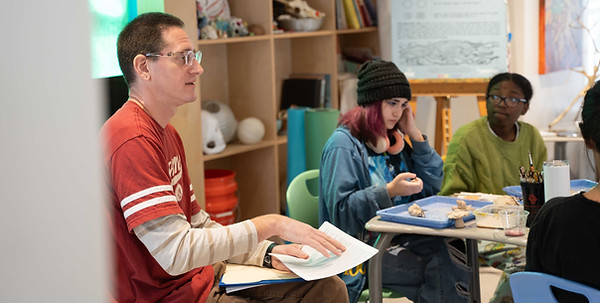



Wide Horizons is a program of art, science, and action for 8th grade students on the Gulf Coast. The program’s activities blend marine science, environmental history, geography, and multimedia self-expression in order to deepen understanding about the environmental and societal importance of the Gulf of Mexico, its landscapes, and its wildlife.
Wide Horizons is inspired by the art, writings, and philosophies of Walter Inglis Anderson (1903-1965), the Gulf’s cultural patron saint and a believer in the paradigm-shifting potentials of experiential education and exploration. Anderson’s legacy provides a blueprint for connecting ecological and societal cause-and-effect with the agency of the individual to direct civic and environmental action.

WAMA is inviting proposals from artists to collaborate on a multi-day art engagement with a selected group of eighth-grade students (10-15 members) as an expression of their Wide Horizons immersive experiences and their relationship with the Gulf of Mexico. This multi-day art engagement will yield a public facing product to be shared with the community that may blend or range from public sculpture, mural, and installation, to online presentations and in-person performative social activity.
In partnership with the Pascagoula River Audubon Center (PRAC) and The University of Southern Mississippi’s Marine Education Center (MEC) and Center for STEM Education, the Museum is offering multi-day experiences that include:
ART & SCIENCE FIELD DAYS (Fall 2023-Spring 2024): Full-day standards-based field trips to all three partner sites, with time spent observing the biomes of the Pascagoula River watershed, conducting marine science on the open water, and learning from artist Walter Anderson’s epic connections to his Gulf Coast environments. Students will play the role of citizen scientists, learning about the intersections of environment and society through journaling, art making, data-gathering, and peer-to-peer dialogue.
CLIMATE ACTION PROJECTS (Fall 2023-Summer 2024): Back in their classrooms and in their communities, students work with Museum educators and visiting artists to create a public-facing art project targeting a local environmental issue. These projects may take the form of exhibitions, murals, performances, or citywide installations.
Travel, materials, and fees are supported through the Museum, which means no cost to teachers and students. This opportunity, available to a select few Gulf Coast 8th grade teachers and students, is valued at more than $10,000.
ARE YOU AN 8TH GRADE EDUCATOR ON THE MISSISSIPPI GULF COAST WHO IS INTERESTED IN BEING A PART OF THIS PROJECT?
STUDENT/CLASSROOM ELIGIBILITY AND REQUIREMENTS
-
This opportunity is available to 8th grade Mississippi Gulf Coast educators and their students
-
While this program is weighted toward science, teachers/students may come from a variety of subject areas
-
Teachers/Schools must commit to:
-
Recruit/secure approximately 50 students for the full-day field trip
-
Ensure students complete program Pre-Test (as required by funder)
-
Prior to the field trip, devote class time to show students a Wide Horizons digital presentation that introduces key concepts
-
Complete program Post-Test following visit
-
After the visit, make students available during and outside school hours, as needed, to work with visiting artists on standards-based Climate Action Projects. Climate Action projects will require approximately 5 full days of work with the visiting artist, which can be scheduled in coordination with schools and students.
-
Partner with the Museum to schedule and help promote a community unveiling of the students’ Climate Action Project.
-
COLLEGE AND CAREER READINESS STANDARDS SERVED INCLUDE:
L.7.9B Students will demonstrate an understanding of the relationship between natural phenomena, human activity, and global climate change.
VA: Cr2.1.8 Organize and develop artistic ideas and work.
Demonstrate willingness to experiment, innovate, and take risks to pursue ideas, forms, and meanings that emerge in the process of art-making or designing.
VA: Re7.1.8 Perceive and analyze artistic work.
Explain how a person’s aesthetic choices are influenced by culture and environment and impact the visual image that one conveys to others.
VA: Cn11.1.8 Relate artistic ideas and works with societal, cultural, and historical context to deepen understanding.
Distinguish different ways art is used to represent, establish, reinforce, and reflect group identity.
History/ Civics: 7C.1 Understand the various roles and expectations of citizens throughout the world and apply that understanding to their role as a citizen of their community, state, and nation.
Ecology & Interdependence: E.8.10 Students will demonstrate an understanding that a decrease in natural resources is directly related to the increase in human population on Earth and must be conserved.
Ecology and Interdependence: L.7.3.4 Explain how disruptions in cycles (e.g., water, oxygen, carbon, and nitrogen) affect biodiversity and ecosystem services (e.g., water, food, and medications) which are needed to sustain human life on Earth.
Ecology and Interdependence: L.7.3.5 Design solutions for sustaining the health of ecosystems to maintain biodiversity and the resources needed by humans for survival (e.g., water purification, nutrient recycling, prevention of soil erosion, and prevention or management of invasive species).









